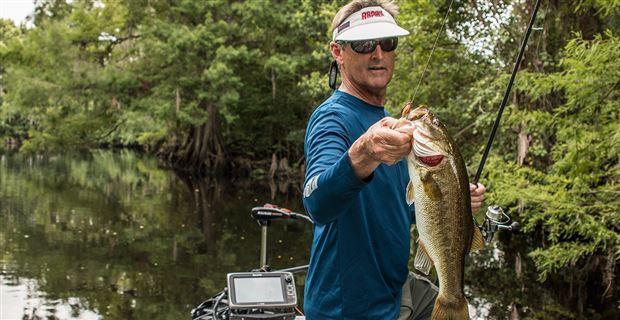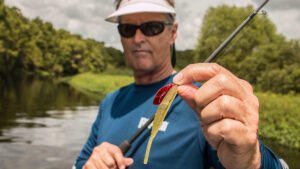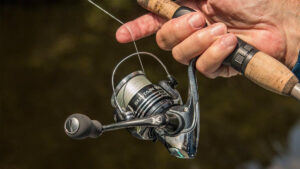Warming temperatures mean two things for many bass anglers: Increased fishing pressure and lethargic bass. Throughout much of the country, the fish are in an awkward transition phase between spring and summer and to make matters more difficult, they’re getting bombarded with every lure you can imagine.
So in a nutshell, they’re getting tougher to catch.
Elite Series pro Bernie Schultz has been experimenting with gliding jigs recently and has found them to be hugely advantageous when faced with finicky bass. With a little knowledge and time on the water, you can utilize these unusual jigs and enjoy an increase in the quantity and quality of your catch.
What exactly is a gliding jig?
In the older—and simpler—days of bass fishing, savvy grass anglers began threading worms onto the backs of Johnson Silver Minnows. They’d implement a steady retrieve around thick vegetation and drop the modified lure into small holes to coax big bass. Schultz believes that this may have been the inspiration for today’s gliding jigs.
“The VMC Gliding Jig is similar to the planer boards anglers troll behind the boat for walleye,” Schultz said. “The willow or Oklahoma blade allows a small soft plastic to fall at a much slower rate. As it descends on slack line, the jig will swim, shimmy and glide its way to the bottom and give your plastic a much more lifelike and realistic appearance.”
Instead of a generic Texas rig or shaky head, gliding jigs never fall the same way twice. When the bass are in a negative mood, this erratic action will often elicit ferocious reaction strikes when more traditional offerings fail.
Smaller is better
While bigger lures are certainly trending in modern-day bass fishing, maintaining a diminutive profile pays substantial dividends when you’re using gliding jigs; not only in regards to presentation, but casting accuracy as well.
“The whole key is to avoid overpowering the gliding jig with a bulky soft plastic,” Schultz said. “You’re dealing with a small blade, so you need a subtle soft plastic in order to take advantage of that slow, seductive fall. When it comes to casting, these jigs will skip like a flat rock if you use a plastic void of appendages. A small crawfish-shaped plastic is the largest bait I’d use on a gliding jig.”
To be clear, we’re not talking 6 and 7-inch worms with the VMC Gliding Jig. Schultz opts for dantier offerings such as the 4-inch Yamamoto Kut Tail Worm, Yamamoto Shad Shape Worm or Yamamoto Thin Senko.
How to fish it
The beauty of a gliding jig is found in its simplicity. While it will take a bit of practice and experimentation to fully learn the most effective methods, anglers will quickly get the hang of it and discover its full potential.
“The tendency for a lot of anglers—even professionals—is to maintain direct contact with the bait at all times,” Schultz said. “If you try this with the VMC Gliding Jig, you’ll significantly impede its action. You have to let it fall on completely slack line because the more freedom it has on the fall, the more action it will create. When you start experimenting with it, I’d suggest finding some clear water in order to observe the jig’s behavior. This will give you a solid idea of exactly what the bait’s doing when you put it around the bass.”
http://www.scout.com/outdoors/wired2fish/story/1632162-finesse-fishing-bass-with-gliding-jigs Once your gliding jig falls to the bottom on slack line, avoid the temptation of dragging it along the bottom. Remember, the beauty is in its fall, so short hops and long, upward sweeps of your rod tip will lift the jig off the bottom and facilitate the erratic fall that makes it so effective.
“It’s very important to watch your line while the jig is falling,” Schultz said. “A lot of your bites will occur before it even hits the bottom, so keep an eye out for any jumps or ticks in your line. When you see your line moving, it’s time to pop ‘em. The hookset is nothing special; just a winding, upward hookset will result in an excellent hookup ratio.”
Head size and blade color
As cliché as it sounds, there are no specific guidelines when it comes to the head size of your gliding jig. The preferences of summer bass can change by the minute, so constant experimentation is necessary. In the name of efficiency, however, Schultz uses a straightforward system to cover water quickly to find concentrations of bass.
“I typically start with the heavier 3/16-ounce VMC Gliding Jig because its quicker fall lets me fish a given area faster,” Schultz said. “But if I’m not getting many bites, I’ll switch to a 1/8-ounce jig and finesse ‘em a little more. Between those two sizes, you should be able to catch plenty of bass.”
Blade color can also be kept simple depending upon the weather and water conditions. In clear water or in sunny conditions, a silver-colored blade will provide maximum flash. When you find yourself in off-colored water or fishing under cloudy skies, Antique Copper or Antique Gold are excellent color choices.
Recommended gear
Chances are, your current spinning outfit will work quite well for gliding jigs. Rigging an appropriate setup shouldn’t be too difficult, but a few specific considerations may help you catch some extra fish this summer.
“I prefer a 6-foot, 6-inch medium or medium-heavy action spinning rod,” Schultz said. “I like a faster tip because it helps me skip the bait underneath docks and overhangs a bit easier while also giving me some extra sensitivity for bite detection. In regards to line, use what you’re comfortable with whether it’s straight fluorocarbon or a braid-to-fluorocarbon setup. I personally use 6 to 10-pound Sufix NanoBraid Aqua Camo because it floats on top of the water and lets me see even the smallest jump in my line as the gliding jig is falling.”
If you’re having a hard time catching summer bass and it seems like you’ve tried everything, make an effort to spend some time with gliding jigs. The bass rarely see ‘em and thanks to their flash, vibration and unpredictable fall, they can play a major role in your summer bass fishing trips this season.














